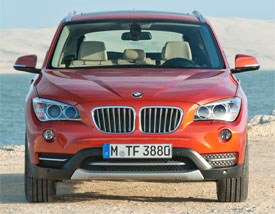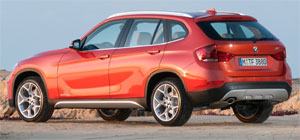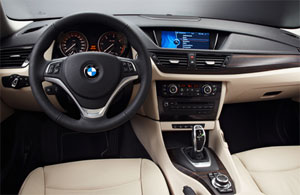2013 BMW X1
BMW’s approach to sport utility vehicles, or sports activity vehicles as they like to call them, has been pretty consistent. And that’s to give buyers the room of a utility, but with much of the performance that you expect in a BMW. Well, now they’ve taken that formula even farther… or should we say, smaller, with the all-new X1.
 The 2013 BMW X1 Sports Activity Vehicle is not actually an all-new vehicle; at least not in Europe where it has been on sale for a couple of years. But, this sub-compact crossover is fresh for us in the U.S. Built with a mix of both 1 and 3 Series parts, you might think it is directly aimed at luxury crossover buyers looking for everyday utility in an ever smaller package. But, there’s more to the X1 than that.
The 2013 BMW X1 Sports Activity Vehicle is not actually an all-new vehicle; at least not in Europe where it has been on sale for a couple of years. But, this sub-compact crossover is fresh for us in the U.S. Built with a mix of both 1 and 3 Series parts, you might think it is directly aimed at luxury crossover buyers looking for everyday utility in an ever smaller package. But, there’s more to the X1 than that.
At 176.5 inches, the X1’s length is about 6½ inches shorter than an X3. But, it’s also about the same as the 3-Series Sport Sedan of a decade ago. At 60.8 inches it is also more car-like in height; taking some 9 inches off the X3. Plus, it’s the first BMW SAV available in rear-drive as well as all-wheel.
So, one might consider the X1 more of a compact 5-door hatchback, or sport wagon, than crossover, and even a plausible alternative to the ever growing 3-Series.
Except for one thing. The X1 is very un-sporty car looking. It’s an awkward two box shape with a long hood leading to a rather bulbous greenhouse. So, BMW’s Sports Activity Vehicle moniker still fits best.
The X1 is all BMW though; with kidney grilles, 17-inch alloy wheels  with run-flat tires, rising character lines, and sporty flared wheel arches, all portraying brand heritage.
with run-flat tires, rising character lines, and sporty flared wheel arches, all portraying brand heritage.
For the full BMW effect, opt for the M Sport package and get upgraded suspension bits behind 18 or 19-inch double spoke wheels.
Engines are familiar BMW fare, with our xDrive28i packing the 2.0-liter TwinPower turbo I4. It provides more than adequate motivation with 240-horsepower and 260 lb-ft. of torque. But, its “rough around the edges feel” again befits a crossover more than a 3 Series.
It’s connected to an 8-speed automatic that includes both Sport and Eco-Pro modes, as well as automatic stop/start.
All aimed at better Government Fuel Economy Ratings fuel of course which with xDrive are 22-City, 33-Highway, and 26-Combined which is a decent boost over the X3.
Still, it makes for a better than average Energy Impact Score, inhaling 12.7-barrels of oil a year while exhaling 5.3 tons of CO2.
For more power, upgrade to the xDrive35i with the X3’s 300-horsepower inline-6.
If one does go the xDrive all-wheel-drive route, they’ll find its multi-plate clutch just as eager to help out with dry road handling as it does winter traction. Particularly when you add Performance Control from the M Sport Package.
We used all available traction in our xDrive28i to depart the starting line on our way to 60 in 6.4-seconds. Down the strip power felt strong and shifts brisk, helping us eclipse the quarter mile in 14.9-seconds and 91 miles-per-hour, accompanied by a very inspiring, and yes, sporty exhaust note.
Handling was plenty inspirational as well; our xDrive’s hydraulic steering delivered tidy turn-ins, obedient exits, and much more feel than the electric steering fitted to the rear driver.
On braking, stops were smooth and consistent, averaging a decent 120-feet, but there was a lot of pedal vibration that gave us an uneasy feeling.
 So, overall performance is about what you expect from any BMW, though if you’ve spent much time in an older 3-Series, it still comes up a little short.
So, overall performance is about what you expect from any BMW, though if you’ve spent much time in an older 3-Series, it still comes up a little short.
Also consistent with other BMWs is the peaceful feel inside the X1’s cabin. We’re fans of the overall layout and fit and finish is excellent. Up front you’ll find plenty of room; but in the rear, not so much.
Seat up cargo capacity is again more sedan-like than crossover at 14.8 cubic-ft.; an adequate 47.7 cubic-ft. with seat backs folded.
The X1’s ride quality is classic BMW, feeling both more lively and quicker to respond than the slightly larger X3. It’s also much easier to maneuver in tight spaces.
For even more help, an optional Driver Assistance Package comes with both Park Distance Control and Rear-view Camera.
Pricing starts at $31,545 for the rear-drive sDrive28i, while the all-wheel drive xDrive28i starts at $33,245. But, adding options can quickly send you into the mid-40’s.
We very much enjoyed our time in the 2013 BMW X1. It is a well done effort, bringing back much of the driving joy of smaller 3 Series of yore, while still being elastic enough when it comes to daily needs. That’s a niche that no other near-term subcompact ute is likely to hit.
But, does a really small luxury crossover make sense in America? The X1 is indeed a risk for BMW and other prestige brands entering the same arena. But, as they say, you gotta to play to win.
Specifications
- Engine: 2.0-liter TwinPower turbo I4
- Horsepower: 240
- Torque: 260 lb-ft.
- 0-60 mph: 6.4 seconds
- 1/4 mile: 14.9-seconds @ 91 mph
- 60-0 mph: 120 ft
- EPA: 22 mpg city / 33 mpg highway
- Energy Impact: 12.7 barrels of oil/yr
- CO2 Emissions: 5.3 tons/yr
2025 Infiniti QX80
Infiniti’s Flagship SUV Sets A Course For Extravagance
This full-size Infiniti QX80 started out as the QX56, a hastily rebadged version of Nissan’s truck-based Armada full-size utility. That was in the early 2000s when the luxury SUV craze was exploding. It wasn’t as much as a game-changer, as it was “try to keep upper”. Now, this new QX80, Infiniti is promising to “Reimagine the luxury SUV”. Let’s see if Infiniti has turned their imaginations into reality.
Well, if over the top is what Infiniti was shooting for in the all-new 2025 QX80, mission accomplished. There’s an overall feeling of extravagance here that we haven’t experienced from Infiniti in quite some time.
It’s not just the open pore ash wood trim with aluminum inlays, 24-speaker audio, and plush quilted leather seating; there’s also nicely integrated ambient lighting, a massive glass roof, plenty of tech, lots of active driving assistance, and even chilled center console storage. Forward of that is a dual touchscreen setup; the top 14.3-inch touchscreen for infotainment sits next to the digital gauge display in a single housing; while just below, there’s a 9-inch one for climate controls.
You are reminded this is still a body-on-frame utility the moment you have to climb up into the cockpit, but there’s also the commanding view of the road that comes with that. Captain’s chairs are standard for the second row, but a three-place bench is optional with all trims except for top Autograph which comes exclusively with these climate-controlled massaging chairs, along with a touchscreen control panel. The third-row experience is great, too, with heated leather seating, and adult size room for three.
Now, there is a whole new experience coming from under the hood. The last gen’s V8 has been replaced with a new twin-turbo 3.5-liter V6 rated at 450 horsepower, 50 over the V8. More notably, torque is up by more than 100 lb-ft to 516. Transmission is a nine-speed automatic, two more gears than last year, with rear-wheel drive standard, four-wheel drive an option. Max tow rating is 8,500-lbs.
And at the test track, it did pull strongly off the line, getting up to speed in a hurry with the 0-60 sprint taking just 6.3 seconds. There is roughly 3 tons of weight to push through the quarter-mile, but that twin-turbo does it well, finishing in 14.7 seconds at 95 mph. Gear changes are incredibly smooth, while not hindering acceleration in any way.
It's an impressive looking utility from any angle.
In panic braking runs, there was some fade and a considerable amount of nosedive, but our average stopping distance of 115 feet is not bad for a vehicle as big and heavy as the QX80. Last gen, the QX80 moved from the Titan truck platform to the global Patrol SUV chassis, which shifted the vibe from budget Escalade to Lexus LX fighter. The attending improvement in ride and handling was the real bonus, and that largely continues for this gen with air suspension and Dynamic Digital Dampers on all but base QX80s. While we could certainly feel all that weight through our cone course, body roll was well-controlled and without significant oversteer or understeer.
It’s an impressive looking utility from any angle, starting right up front with the big “bamboo forest” grille. The overall shape is boxy, but all body panels are smooth; and for better or worse, Infiniti joins the flush door handle fad. Look for its “Artistry In Motion” design theme to work its way down through the rest of the Infiniti lineup. All QX80s ride on 22-inch wheels except for base Pure trim which makes do with 20s.
A full power play includes standard motion-activated rear liftgate and power operation of both second and third row seats, expanding cargo capacity from 22 cu-ft behind the third row to 59 behind the second, and a max of 101.0 cu-ft with both rows folded.
Government Fuel Economy Ratings with four-wheel-drive are not great: 16 city, 19 highway and 17 combined. We averaged 18.6 mpg of premium. That’s a much worse than average Energy Impact Score, using 17.5 barrels of oil annually, with 8.6 tons of CO2 emissions.
Driving such a PUREly LUXEurious SENSORY overload, you’ll probably be expecting people to want your AUTOGRAPH, which we’re guessing is how Infiniti came up with their grade structure; pricing starts with Pure at $84,445 and climbs to $112,590 for Autograph.
The 2025 Infiniti QX80 is a massive SUV that delivers massive amounts of power and luxury. They aimed for the moon here and have clearly blasted themselves into a much more competitive orbit in the big buck, big hauler, sport-utility galaxy.
Specifications
As Tested
- Engine: 3.5-liter twin-turbo V6
- Transmission: 9-speed automatic
- Horsepower: 450
- Torque: 516 lb-ft.
- EPA: 16 City | 19 Highway | 17 Combined
- 0-60 mph: 6.3 seconds
- 1/4 Mile: 14.7 seconds at 95 mph
- Braking, 60-0 (avg.): 115 feet
- MW Fuel Economy: 18.6 mpg (Premium)
2025 Honda Civic Si & Hybrid
More Fun, More Refinement, More Civic
If you’re looking at buying a Honda Civic Si instead of a standard Civic, chances are, you’re the kind of driver that actually enjoys being behind the wheel and wants a fun-to-drive car that injects some pure enjoyment into your daily grind. Well, good news! There’s an updated Civic Si that promises to deliver more fun and refinement than ever!
The 2025 Honda Civic Si spearheads a revised Civic lineup that also sees the return of a Hybrid to the roster, something that’s been missing since 2015. This 11th-gen Civic first arrived for 2021, and gets a slightly more aggressive look for ‘25 with an updated front fascia and grille.
And while it remains available as either a four-door sedan or five-door hatchback, the Si comes only as a sedan with a hex pattern grille, gloss black trim and aero enhancements, both up front and in the back, with a decklid spoiler. Other Si upgrades include larger brakes and 18-inch V-spoke wheels for the optional summer performance tires.
Honda claims the chassis has been stiffened and the suspension retuned for 2025; and it certainly makes for a fun driving little car, though it’s hard to call this current Civic little anymore, as dimensions and interior space are more midsize these days. Under the Si’s hood is Honda’s tiny but mighty 1.5-liter turbo-four engine, furiously spinning up its 200 horsepower and 192 lb-ft of torque. The Si comes exclusively with a six-speed manual transmission with a miniature shift knob and very light clutch enhancing its definitely playful vibe.
At our test track, once we got some heat in the front tires and figured out the best traction control settings, we were able to rip off consistent 6.9-second runs to 60. Not crazy quick, but the free-revving engine and manual trans made for a totally engaging experience. Our best quarter-mile, 15.1 seconds at 94 mph. But it was in our handling course where the fun really jumped up, slicing through the cones like we were in a video game. Yet it also felt well planted the entire time, grip was plentiful, and body roll minimal. Consistency, too, in braking runs, repeatedly stopping in a mere 92 feet from 60 mph.
Our handling course [is] where the fun really jumped up, slicing through the cones like we were in a video game.
No matter which Civic you choose, you’ll get plenty of standard content, including auto climate controls and illuminated steering wheel controls, plus more color choices for ’25. The funky lattice-style dash trim carries over, the Si getting racy red accents and manually-adjusted cloth seats that definitely are sporty. While over in the Hybrid, things take a classier turn with Sport Touring getting leather-trimmed seats, the 9-inch version of their touchscreen infotainment setup with Google built in, a 10.2 digital instrument cluster, 12-speaker Bose audio, and wireless phone charging.
Following Honda’s current marketing strategy, the returning Hybrid will be available in upper trims only, specifically Sport and Sport Touring. It uses a combination of naturally aspirated 2.0-liter I4 engine and Honda’s Two Motor Hybrid system for a 200-horsepower total. Yes, that’s exactly the same as the Si, and the Hybrid setup out-torques bigtime with 232 lb-ft, 40 more than the Si.
The hatchback’s Government Fuel Economy Ratings are 50 city, 45 highway, and 48 combined. We only managed to wrangle 43.5 mpg of regular in our wintertime driving loop.
The Sedan’s numbers are a little better than the hatchback’s; and while that additional fuel economy is great, with all of that torque, the new Civic throws it back to the original Accord Hybrid, having a bit of a performance bent to it, including a Sport Drive mode that heightens throttle response and tightens up steering. It also gets a unique gauge display and active sound inside the cabin. There are also four levels of regen braking with shifter-style adjustment paddles on the back of the steering wheel. And unlike the Si, you can get the Hybrid as a five-door hatchback, which most of our staff really enjoy looking at and everyone can appreciate its 24.5 cu.-ft. of cargo space and folding seatback flexibility.
Civic pricing starts at $25,400 for a base LX sedan. Hybrids start with Sport Hybrid at $30,100. The hatchback is a bit more at $31,300. Si comes in at $31,400, just below the range-topping Sport Touring Hybrid at $33,100.
While at times the Civic has been more of a blank canvas that buyers could customize to make it their own, this 11th-gen already offers something for just about everyone, whether you’re a high-revving gear shifting driving enthusiast, a luxury-minded fuel sipper or something in between. The 2025 Honda Civic is the total package. One high quality, not-so-small car that delivers more fun and more refinement than ever.
Specifications
Civic Si
- Engine: 1.5-liter turbo-four
- Transmission: 6-speed automatic
- Horsepower: 200
- Torque: 192 lb-ft
- 0-60 mph: 6.9 second
- 1/4 Mile: 15.1 seconds at 94 mph
- Braking, 60-0 (avg): 92 feet
Civic Hatchback Hybrid
- Engine: NA 2.0-liter I4
- Transmission: eCVT
- EPA: 50 City | 45 Highway | 48 Combined
- Horsepower: 200
- Torque: 232 lb-ft
- MW Fuel Economy: 43.5 mpg

































































































































